Charles of the Ritz (post 1945)
Continued from: Charles of the Ritz (1936-1945)
Between 1945 and 1961 – the year that Charles of the Ritz went public – the company made a number of acquisitions. Some of these, such as Cosmo Chemical (1947) and the Venus Pen & Pencil Corporation (1959) were to help with production but Alexandra de Markoff (1949) and Anatole Robbins (1959) were well-established cosmetic lines. Anatole Robbins looks to have been disbanded after it was bought, with its Countess Isserlyn line folded into Alexandra de Markoff.
By 1958, Charles of the Ritz also appears to have wound up the Velo-Derma Company which it had established in 1933. However, some Velo-Derma products survived – most notably Velo-Derma 770 Lotion – by being added to the Charles of the Ritz range. Velo-Derma 770 Lotion looked out of place within Charles of the Ritz and it was renamed as Firmessence 770 by 1969, later still becoming Revenescence Firmessence 770. In the 1970s, the ‘seven drops’ idea, used by Velo-Derma in the 1930s, was also repurposed by Charles of the Ritz for its Liquid Revenescence.
In 1957, Charles of the Ritz opened the Ritz School of Advance Hair Fashions, Ltd. in New York and followed this with a new, elaborately decorated salon in the Ritz Tower, New York in 1958. Louis XVI style chairs were used in the hairdressing salons, while marble-looking vinyl floor tiles mimicked the floors of French and Italian palaces. The company also increased the number of salons it operated across the United States doubling their number between 1955 and 1959.

Above: 1961 Charles of the Ritz salons.
In 1955, Charles of the Ritz also expanded into France with its products becoming available through a number of Parisian parfumeries, salons and department stores and was established in Brussels by 1958. The company also opened a salon and shop at 51 Avenue Montaigne, Paris in 1956.

Above: 1958 A treatment room in the Charles of the Ritz Paris salon.
In 1962, a separate French company was formed – Charles of the Ritz S.A. – based at 100 Rue Chaptal Levallois-Perret, Hauts-de-Seine, Paris.
Skin-care
Revenescence Cream, Lotion and Mask continued to be a major selling points for Charles of the Ritz.

Above: 1950 Charles of the Ritz Revenescence Cream and Lotion advertised in Britain.
When Charles of the Ritz introduced Sun-Bronze (1947), a tanning lotion with a sunscreen, this was also promoted as being based on Revenescence as was Deep Tone Sun Bronze.
Sun Bronze: “[T]he only sun lotion that contains Revenescence Liquid. This skin treatment within a sun lotion encourages a rich, golden tan while protecting the skin against the harmful effect of the sun.”
Deep Tone Sun Bronze: “[I]s the same as Sun Bronze but with the addition of a honey colored tint that lighty tans the skin as it encourages the sun to work safely.”
Along with the previously mentioned Velo-Derma 770 Lotion, other skin-care products added through to 1961 included: Velvet Foam Cleanser (1953), a soap-and-water cleanser without soap; Special Formula Emollient (1955), made from vegetable, mineral and organic oils to supplement the natural oils of older skin; Disaster Cream (1958) to heal, dry and soothe skin blemishes; Astringent Cream (1958) to reduce the appearance of large pores; and Dual Lotion (1961) containing alcohol and menthol to freshen and cleanse.
Velvet Foaming Cleanser: “Soapless facial wash that cleans your skin without the harsh and irritating effects of ordinary soap-and-water washing.”
Special Formula Emollient: “[A] formulation of essential oils which, in their skillfully processed combination, give the dry skin the greatest lubrication possible. It disappears immediately on the skin making it particularly convenient for the woman who likes to leave her lubricant on overnight.”
Disaster Cream: “[C]alms the temporary flare-up of blemishes as it works its drying benefits. Can also be used for spot application during the day as it is skin-tone in color.“
Astringent Cream: “Created to help mature skin look firmer, finer textured and younger, … gives a feeling of tightness on the skin, temporarily reduces the appearance of large pores. Leaves skin soft, smooth, without drying.“
Dual Lotion: “[R]emoves all traces of oil from the skin and also stimulates surface circulation to give the face a rosy, fresh, youthful glow.”
By 1960, Charles of the Ritz had combined these new preparations with older products, such as Sensitive Skin Cleanser – now called Feather Touch Cleanser – into its updated skin-care routines. These now emphasised make-up removal with many also stressing the need to moisturise.
Normal Skin Basic Routine
For removing make-up: Feather Touch Cleanser and Skin Freshener
For morning washing: Velvet Foam
For lubrication: Velvet Texture Lotion
For moisture: Revenescence Cream or Liquid Revenescence
Dry Skin Basic Routine
For removing make-up: Normal Skin Cleanser and Skin Freshener or Dual Lotion
For morning washing: Velvet Foam
For lubrication: Special Formula Emollient or Super Rich Cream
For moisture: Revenescence Cream or Liquid Revenescence
Mature Dry Skin Basic Routine
For removing make-up: Normal Skin Cleanser and Skin Freshener or Dual Lotion
For morning washing: Velvet Foam
For lubrication: Special Formula Emollient
For moisture: Velo-Derma 770 Lotion
Oily Skin Basic Routine
For removing make-up: Oily Skin Cleanser and Skin Freshener or Dual Lotion
For morning washing: Velvet Foam
For blackheads: Special Lotion and Special Cream
For reducing large pores: Mild Astringent or Astringent
Problem Skin (using no make-up) Basic Routine
For washing: Velvet Foam
For daytime wear: Medicated Lotion
For overnight use: Disaster Cream
Problem Skin (using make-up) Basic Routine
For removing make-up: Oily Skin Cleanser and Skin Freshener or Dual Lotion
For morning washing: Velvet Foam
For daytime wear: Medicated Lotion
For overnight use: Disaster Cream
For special care: Facial Glow
Sensitive Skin Basic Routine
For removing make-up: Feather Touch Cleanser and Skin Freshener
For morning washing: Velvet Foam
For lubrication: Velvet Texture Lotion
For moisture: Revenescence Cream or Liquid Revenescence
Other products such as Facial Glow, Throat Cream Plus, and Revenescence Mask could be recommended for particular problems.
Also see: Charles of the Ritz Sales Manual – Treatment Preparations
Youth market
In 1949, Charles of the Ritz bundled its Medicated Cream and Medication Lotion together to form a day/night treatment regime referred to as the Medicated Duo.
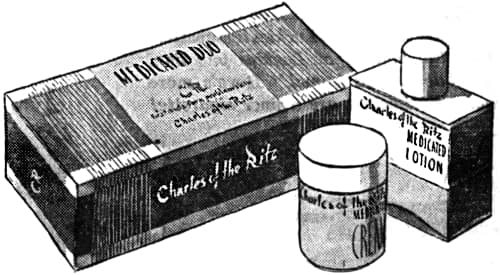
Above: 1949 Charles of the Ritz Medicated Duo.
Medicated Lotion – which came in Light and Dark tones – was used during the day to conceal blemishes while it worked. Charles of the Ritz suggested it could also be used as a powder base. At night, there was Medicated Cream applied as a thin film. This was left on the skin for half an hour, before being tissued off leaving a little behind to work overnight.
When Charles of the Ritz added Velvet Foam Cleanser in 1953 it was added to the routine to be used before applying either the Medicated Cream or Lotion. Described as non-alkaline, Velvet Foam was neutral with a pH of seven. In 1958, Medicated Cream was then replaced with Disaster Cream. Like the Medicated Lotion this was also coloured so it could cover spots during the day as well as being used overnight. I believe the drying action of the cream came from clay incorporated into the mixture.
Collectively, Velvet Foam Cleanser, and Disaster Cream were combined with the pre-war Medicated Lotion, Special Lotion, and Special Cream to give Charles of the Ritz a skin-care routine for teenage skin, a market that became increasingly important through the 1950s and 1960s.
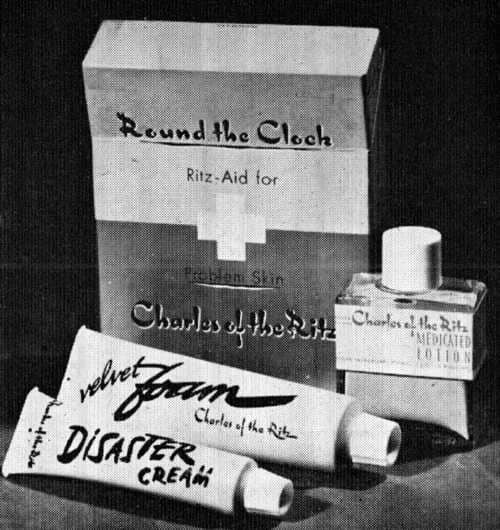
Above: 1958 Charles of the Ritz Round the Clock Ritz-Aid for Problem Skin (Velvet Foam, Disaster Cream and Medicated Lotion).
The face was to be washed with Velvet Foam each morning and night. Disaster Cream could be applied on pimples and other skin blemishes overnight while blackheads were still to be softened and removed with Special Lotion and Special Cream. During the day Medicated Lotion could be applied to cover blemishes with the creamier Disaster Cream used for individual spots.
To help promote its products to younger clients, Charles of the Ritz also conducted Young Beauty Workshops for teenagers in some of its salons.
In 1962, Charles of the Ritz added Miss Ritz Mask. Made as a gel with herbal and balsamic ingredients, it acted as an astringent to help clarify the skin.
Miss Ritz Mask: “[M]akes your skin feel as fresh as the first daisy. Made with Herbal and Balsamic ingredients, this whitish jell in a handy plastic tube takes just minutes to apply, perform and remove. Miss Ritz Mask helps clarify your skin without robbing natural moisture yet lends a pleasant feel of astringent stimulation . . . helps refine the appearance of your skin and gives your complexion the prettiest glow possible. Smells delicious . . . feels even better.”
This was not the first time Charles of the Ritz had used the Miss Ritz name. It had already introduced Miss Ritz as a lipstick and rouge shade in 1958. In 1966, the company introduced a full Miss Ritz range which included make-up, probably a response to the success of Noxema’s Cover Girl.
See also: Cover Girl
Make-up
The new types of make-up pressed powder, stick and liquid make-ups created after the Second World War were an ongoing problem for Charles of the Ritz as they collectively depreciated the need for loose face powders. Charles of the Ritz individually-blended face powder remained a company staple but the company added powder presses into the Charles of the Ritz powder bars in 1956.
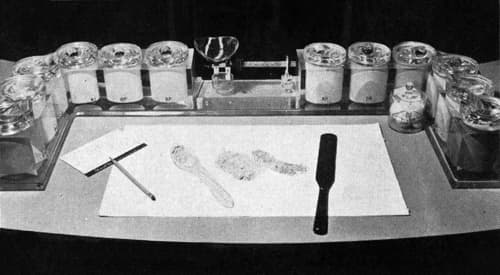
Above: 1956 Charles of the Ritz Powder Bar.
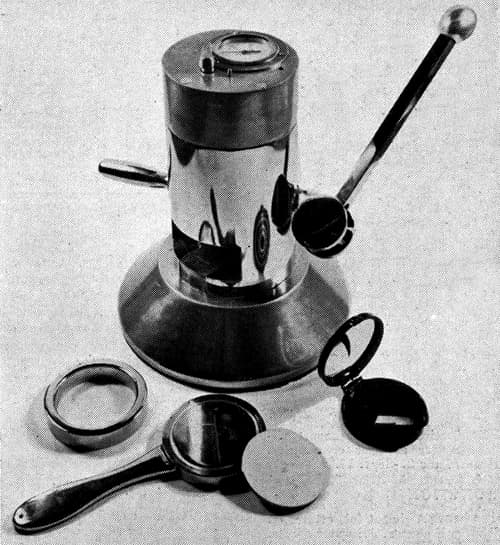
Above: 1956 Charles of the Ritz Powder Press.
The Powder Press enabled a Charles of the Ritz consultant to press an individually-blended powder into a compact. Women had three compacts to choose from – a plastic simulated tortoiseshell case, a swirled gold metal case, and a square gold and silver case with a basket weave pattern.

Above: Charles of the Ritz Compacts for pressed powder in simulated tortoiseshell, basket weave and swirled patterns. Although the simulated tortoiseshell would remain the other patterns would change.
See also: Charles of the Ritz Powder Bars
As highly-coloured face powders gave way to more transparent forms and foundations and pressed cream powders became more popular, the relevance of these individually pressed powders began to decline. Charles of the Ritz would eventually concede defeat and introduce Feather-Touch Pressed Powder (1966) acknowledging that this new transparent powder had to be pressed at the Charles of the Ritz laboratory rather than blended in store. It came in 12 shades ranging from Ivory to Suntan as well as Translucent for those who preferred no colour at all.
Foundations
Charles of the Ritz was hamstrung by its reliance on individually-blended face powders but was free to add additional foundations. In 1951, the company released Liquid Veil, a liquid formulation in six shades, increased to seven by 1952. It formed a similar function to the creamy Complexion Veil that Charles of the Ritz had introduced in 1940. It was advertised as providing complete coverage with a flattering, silken finish and was recommended for sensitive or dry skin. The product was a suspension so needed to be well shaken before it was used.
Liquid Veil: “A liquid veil of loveliness which lends flattering color and coverage to the skin, giving a fine-textured satin-smooth-finish.” Shades: Camellia, Buff, Beige, Amber Rose, Dresden, and Rose Rachel, with Brunette and Suntan added later.
In 1959, Charles of the Ritz then added Astringent Foundation in six shades.
Astringent Foundation: “[T]o give every woman&rsquos skin the appearance of firmer, finer texture as it delicately films with translucent color.” Shades: Beige, Brunette, Camellia, Dresden, Rose Rachel, and Suntan.
This meant that Charles of the Ritz now had five foundations that could be selected according to skin type. Women with Dry Skin or Sensitive Skin could select from Astringent Foundation, Liquid Veil, Complexion Veil, or Skin Bloom Lotion while those with Oily Skin were recommended to used Medicated Lotion or Skin Bloom Lotion, with Medicated Lotion also being recommended for women with Problem Skin.
Lipsticks and rouge
By the late 1940s, Charles of the Ritz had a number of lipstick and rouge shades on the market including Talisman, Hibiscus, Bonfire, Red Pencil, Pink Geranium, Camellia, So Red Rose, Parisienne, Moss Rose, Redwing, Flare Red, Tiger Lily and Claret. These were available in a plain metal cases – introduced in 1945 when metal became available once more – or in a new luxury container introduced in 1947 that came with a built in lipstick brush.

Above: Luxury lipstick case with sable brush.
Charles of the Ritz Compact and Cream Rouges continued on much as before but were supplemented with a new liquid form called Ritz Tint (1957) in four shades – Rose, Coral, Pastel, and True Red. Ritz Tint was applied as a single drop over foundation and then gently smoothed into the skin before being followed with face powder.
The company was not a major player in the American lipstick wars that started with the release of Hazel Bishop’s Long Lasting Lipstick in 1950. However, in 1951, to promote its lipsticks, Charles of the Ritz ran a campaign in American Vogue offering free samples of three of its lipsticks – Claret, Tiger Lily, and Petunia – in the form of matchsticks.
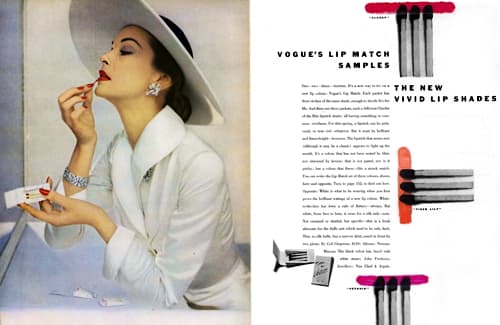
Above: 1951 Charles of the Ritz match samples.
The company must have been pleased with the results of this promotion as it introduced a Lip Stick Wardrobe box of 15 lipstick samples in 1952 in match form. This included Bright Pink and Titian shades, the first new lipstick shades Charles of the Ritz had introduced in five years.

Above: Charles of the Ritz Lip Stick Wardrobe. Shades: Tiger Lily, Titian, Hibiscus, Talisman, Red Pencil, Bonfire, Claret, Redwing, Camellia, Moss Rose, Petunia, So Red Rose, Raspberry Ice, Bright Pink, and Pink Geranium.
Other shades added by the company through to 1961 were: Perfect Red (1955); Perfect Holiday (1956); Sienna (1957); Miss Ritz (1958); Blush (1960); and Sun Bronze, Sun Gold, Sun Coral, Daylight Pink, and Nightlight Red (1961).
As the fashion in indelibles waned in the second half of the 1950s, Charles of the Ritz developed a creamy formulation released as Treatment Lipstick (1957) in a limited shade range. The lipstick was promoted as maintaining the normal acid balance of the skin, something Charles of the Ritz also claimed for its Astringent Cream and Astringent Foundation. In the case of Treatment Lipstick, its acidic pH was said to stop colour changes caused by ‘alkaline deterioration’.
Treatment Lipstick: “[A] beautiful make-up that keeps the thin, sensitive skin of the lips soft, healthy and young looking. … [P]rotects by maintaining normal acid balance and moisturing your lips against weather worries.” Shades: Coral, True Red, Rose, and Pastel.
The lipstick was recommended to be applied twice – ‘light film first then firm application’. Treatment Lipstick could also be used under one of the other twenty plus Charles of the Ritz lipstick shades.
See also: Acid Creams
In 1959, Charles of the Ritz introduced Luster-Sticks, a transparent, pearlised lipstick without a strong colour pigmentation in Pink Lustre, Coral Lustre, and Moon Lustre shades. It could be worn as a base coat under lipstick, to soften and illuminate the colour or as a top coat to add shimmering translucent highlights.
See also: Lipstick Wars
Eye make-up
A number of products in the Charles of the Ritz make-up range had their shade ranges extended. For example, Lashique, a waterproof cream mascara sold in Black, Brown, and Blue shades before the war had its shade range extended to Black, Dark Brown, Blue, Green, Green Lustre, Lavender Lustre, and Turquoise Luster by the 1960s. Charles of the Ritz did not develop its wand/automatic Auto-Lashique mascara until 1965, almost a decade after Helena Rubinstein’s Mascaramatic (1957).
See also: Liquid and Cream Mascara and Automatic Mascara
Other eye make-up products in the range included: Eyeshadow Stick, Liquid Eye Make-up, and Eyeliner Pencil.
Also see: Charles of the Ritz Sales Manual – Make-Up
Hands and nails
Charles of the Ritz continued to sell both a Hand Lotion and a Hand Cream but introduced a new nail polish in 1959. Called Fresh Paint Nail Lacquer, it came in plain and lustre shades that were colour-coordinated with Charles of the Ritz Lipsticks. In conjunction with Fresh Paint, the company developed a new gel nail polish remover that did not evapourate, spill or smear.
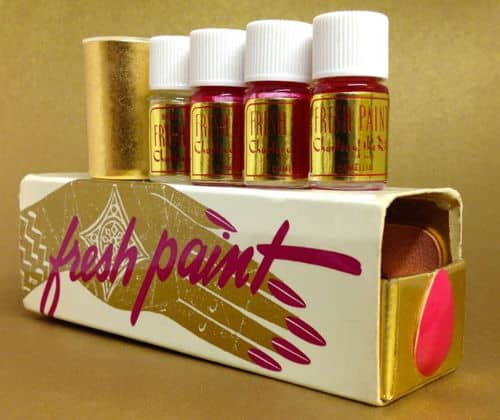
Above: Charles of the Ritz Camellia Fresh Paint. The polish was packaged in three individual bottles to keep it ‘fresh to the last drop’ along with a bottle of the gel remover, a brush which was packaged separately, emery boards and other manicure equipment.
Fresh Paint: “[A] unique nail lacquer, packaged in three individual bottles to keep it fresh to the very last drop. Applies freely, adheres perfectly to the nails and dries quickly to a hard glossy finish.” Shades: Shades: Bonfire, Bright Pink, Perfect Holiday, Perfect Rose, Pink Geranium, Tiger Lily, Plush, Bonfire Lustre, Perfect Holiday Lustre, and Perle Lustre, with Blush (1960), and Sun Bronze, Sun Gold, Sun Coral, Daylight Pink, and Nightlight Red (1961) added later.
Fresh Paint Remover: “[A] non-smear, free-flowing jelly in a bottle which removes nail lacquer quickly and gently.”
Fresh Paint was advertised as not needing a base or top coat but Charles of the Ritz sold both.
Protective Base: “[A] foundation coat to provide a smooth finish for the nail for easy application of Fresh Paint Lacquer.”
Protective Glaze: “[A] high glos, hard finish top coat which insures extra long wear for the Fresh Paint manicure,”
Also see: Charles of the Ritz Sales Manual – Special Preparations
Going public
During the 1950s, Richard Salomon was approached by a number of companies suggesting that Charles of the Ritz should be made into a public company. The company’s net sales and net income had been growing steadily during the 1950s with net income rising from US$309,079 in 1951 to US$931,156 in 1959 (‘Drug and Cosmetic Industry,’ 1961, p. 567) but Charles of the Ritz was still a relatively small company. The reasons offered for going public seemed attractive and Salomon, who had no obvious heir, went ahead with the float. He later came to regret the decision.
In retrospect, it seems to me that for the last ten years of my career the joy of business had vanished. From the day I went public in 1961 to the day in 1972 when I retired on my sixtieth birthday, it seemed to me that I was under constant pressure for performance and not free to act totally in the interest of the business itself. The interests of the short-term share owner too often were not parallel to those of the management.
(Salomon, 1977)
Lanvin-Charles of the Ritz
A number of changes took place at Charles of the Ritz after the company went public. Salomon’s good French connections had already enabled Charles of the Ritz to get the distribution rights to Dior perfumes in the USA, including Miss Dior and Diorama. In 1962, the company secured the world-wide rights to Yves Saint-Laurent perfumes and cosmetics. Richard Salomon was an important reason why Yves Saint Laurent [1936-2008] and his business partner Pierre Bergé [1930-2017] agreed to the deal. The following year the company bought Antoine de Paris, an American company that had the North American rights to cosmetics from the celebrity hairdresser Antoni Cierplikowski [1884-1976].
See also: Antoine
In 1964, Charles of the Ritz merged with Lanvin to form Lanvin-Charles of the Ritz. The following year, the newly formed company bought a controlling interest in the fashion house Yves Saint-Laurent through purchasing the shares of the Georgia businessman J. (Jesse) Mack Robinson [1923-2014]. He had financed the establishment of Yves Saint-Laurent after Yves left Dior.
After acquiring the Dureen Soap Corporation – a leading maker of luxury soap – in 1967, Lanvin-Charles of the Ritz underwent a rationalisation selling off sixteen of its Charles of the Ritz beauty salons to Glemby Co. in 1970. Not included in the deal was the Ritz Tower and Palm Beach salons and the Charles of the Ritz salon in Paris, France. The following year Lanvin-Charles of the Ritz was bought by Squibb-Beechnut.
In 1986 Squibb sold Lanvin-Charles of the Ritz, Inc. to Yves Saint Laurent who then resold it to Revlon minus Yves Saint-Laurent Beauté and Charles of the Ritz perfumes. Revlon tried to revive Charles of the Ritz, even resurrecting the powder bars for a while, but abandoned the line in 2002.
Timeline
| 1947 | Cosmos Chemical acquired. Products available in Australia. |
| 1949 | Alexandra de Markoff purchased. |
| 1953 | New Products: Velvet Foam Cleanser. |
| 1955 | Charles of the Ritz established in France. New London salon opened at 3 Hill Street, Mayfair. Powder presses introduced into Charles of the Ritz powder bars. New Products: Perfect Lipstick. |
| 1956 | Salon opened at 51 Avenue Montaigne, Paris. New Products: Special Formula Emollient. |
| 1957 | Ritz School of Advance Hair Fashions opens in New York. New Products: Treatment Lipstick; and Eyeshadow Stick. |
| 1958 | Ritz Tower Hotel salon in New York refurbished. New Products: Disaster Cream; and Astringent Cream. |
| 1959 | Anatole Robbins acquired. Venus Pen & Pencil Corporation purchased. New Products: Astringent Foundation; Lustre-Sticks; and Fresh Paint Nail Polish and Remover. |
| 1960 | New Products: APD Ritz Antiperspirant. |
| 1961 | Charles of the Ritz becomes a public company. New Products: Dual Lotion. |
| 1962 | Charles of the Ritz S.A established in France. World-wide rights to the name Yves Saint Laurent for perfumes and cosmetics acquired. |
| 1963 | Antoine de Paris bought. |
| 1964 | Charles of the Ritz merges with Lanvin to form Lanvin-Charles of the Ritz, Inc. Parfums Yves Saint Laurent established in Sarl, Paris. New Products: Throat Cream Concentrate. |
| 1965 | Yves Saint Laurent bought from J. Mack Robinson. New Products: Auto-Lashique mascara wand; and False eyelashes. |
| 1966 | Factory in Homdel, New Jersey bought from Mattel, Inc. New Products: Feather-Touch Pressed Powder; Ritual Night Cream; Spotlights liquid make-up; and Miss Ritz range. |
| 1967 | Dureen Soap Corporation bought. New Products: Liqui-Cream Foundation, Lipstick and Nail Polish; and Novessence skin cream. |
| 1969 | New Products: Firmessence face cream. |
| 1970 | Sixteen beauty salons sold to Glemby Co. |
| 1971 | Lanvin-Charles of the Ritz sold to Squibb-Beechnut. |
| 1986 | Lanvin-Charles of the Ritz, Inc. acquired by Yves Saint Laurent. |
| 1987 | Lanvin-Charles of the Ritz, Inc. (including Alexandra de Markoff and Bain de Soleil tanning products but excluding Yves Saint Laurent Beauté and Charles of the Ritz perfumes) sold to Revlon. |
| 2002 | Revlon discontinues Charles of the Ritz. |
First Posted: 21st March 2017
Last Update: 3rd March 2023
Sources
Charles of the Ritz (c.1961). Charles of the Ritz sales manual.
Drug and Cosmetic Industry (1961). May, 88(5).
Rhodes, R. M. (1974). Brown alumni monthly, 75(2), October, 16-17.
Salomon, R. B. (1977). Second thoughts on going public. Harvard Business Review, 55(5), 126-131. Retrieved March 13, 2017 from https://hbr.org/1977/09/second-thoughts-on-going-public

Richard Bernard Salomon [1912-1994]. This photograph was taken in the late 1980s well after he had retired from Lanvin-Charles of the Ritz.
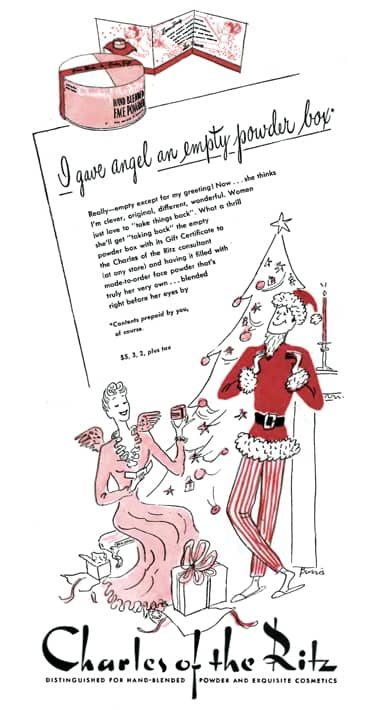
1946 Charles of the Ritz Face Powder.

1946 Charles of the Ritz new packaging.
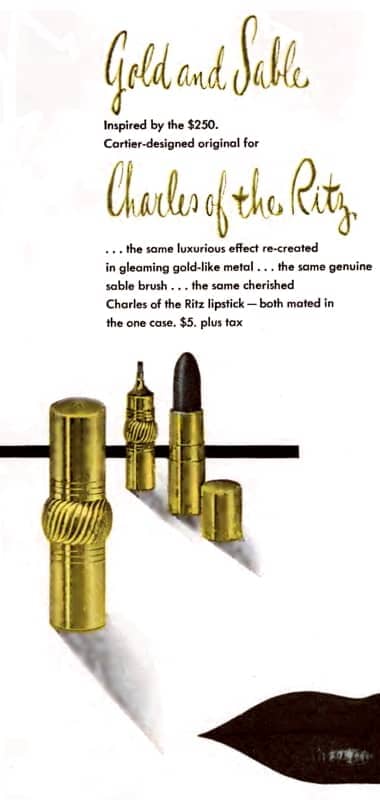
1947 Gold and Sable lipstick case.
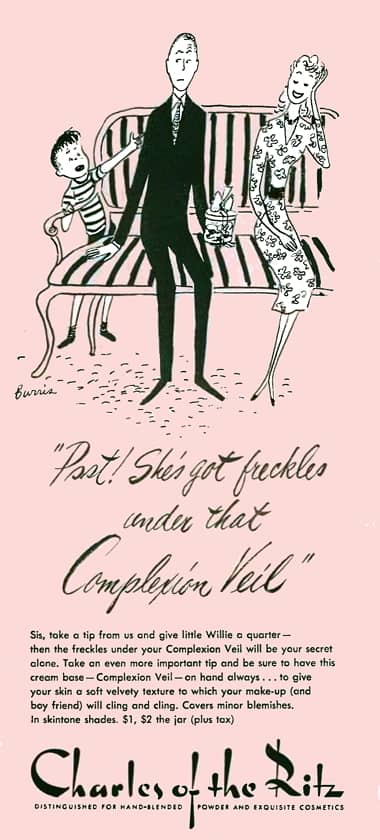
1947 Charles of the Ritz Complexion Veil.
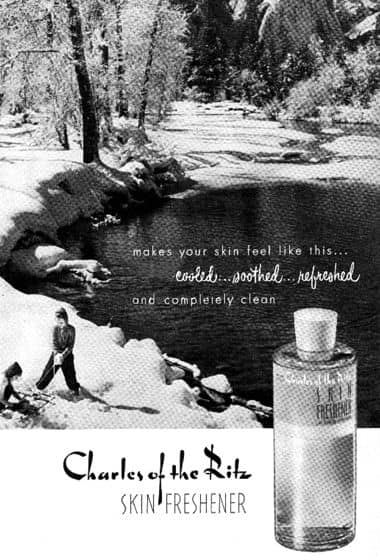
1948 Charles of the Ritz Skin Freshener.
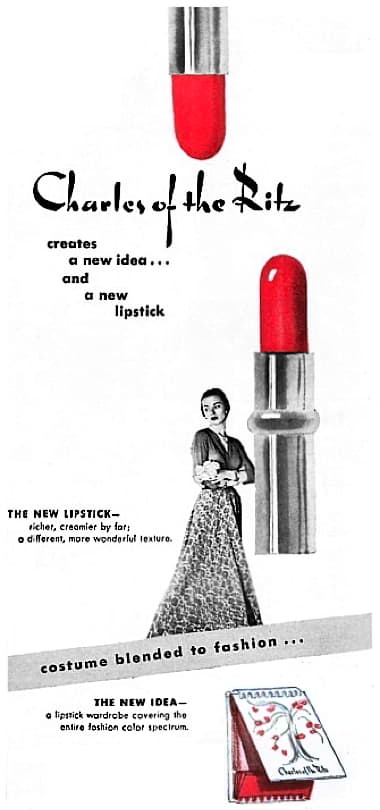
1948 Charles of the Ritz Lipstick Wardrobe.
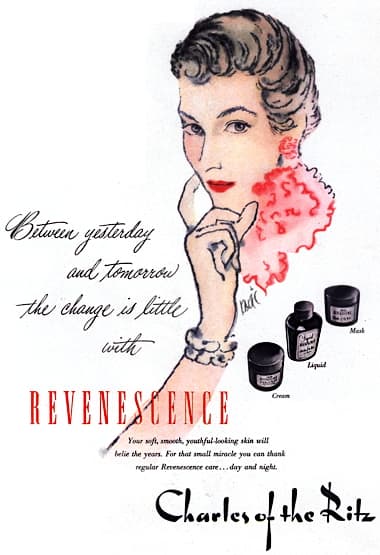
1949 Charles of the Ritz Revenescence Cream Liquid and Mask.
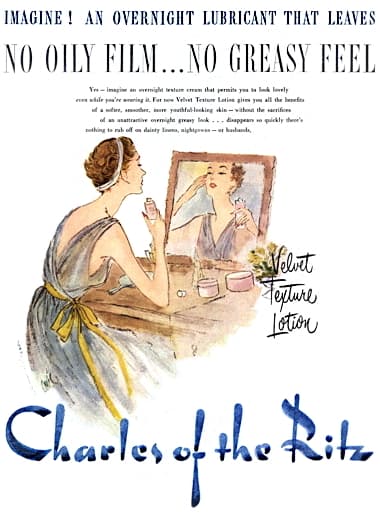
1950 Charles of the Ritz Velvet Texture Lotion.
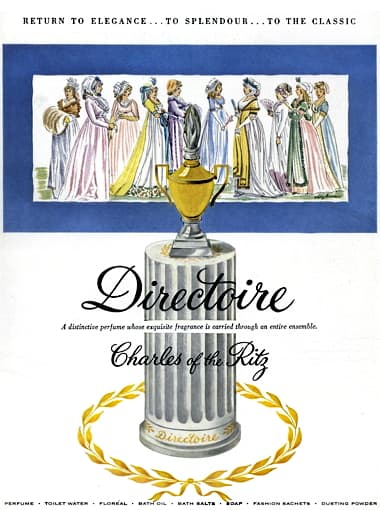
1950 Charles of the Ritz Directoire.

1951 Charles of the Ritz Liquid Veil.

1952 Charles of the Ritz Revenescence (France).

1954 Charles of the Ritz Velvet Foam Cleanser.

1954 Charles of the Ritz Ishar.
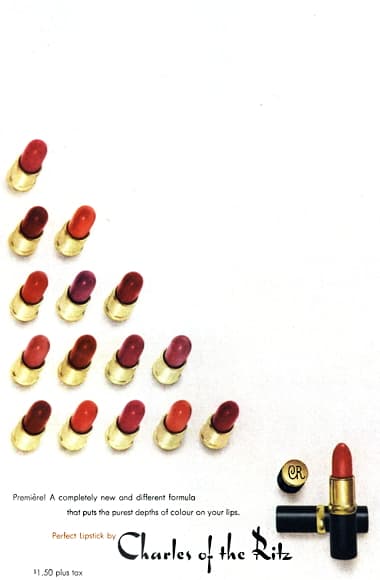
1955 Charles of the Ritz Perfect Lipsticks.

1955 Charles of the Ritz Perfect Rose.
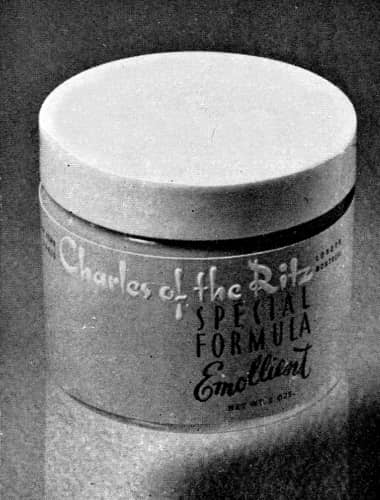
1956 Charles of the Ritz Special Formula Emollient.
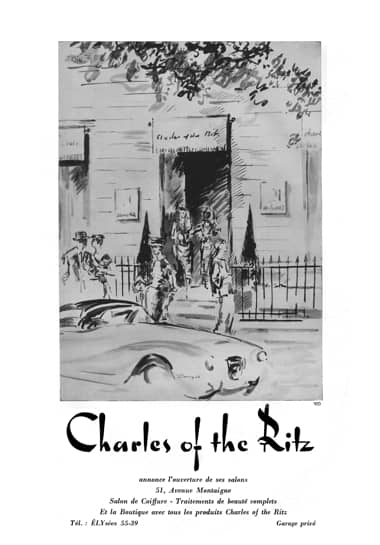
1956 Charles of the Ritz, Avenue Montaigne, Paris.
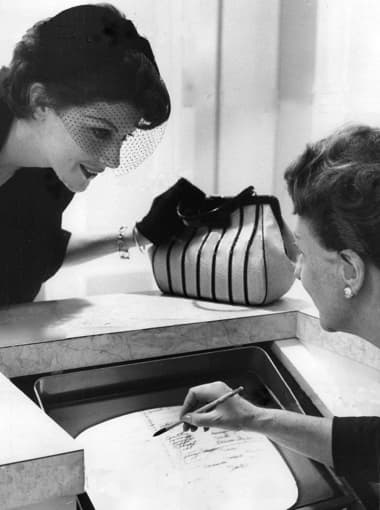
1958 The closed-circuit message centre in the redeveloped Charles of the Ritz salon in the Ritz Tower.
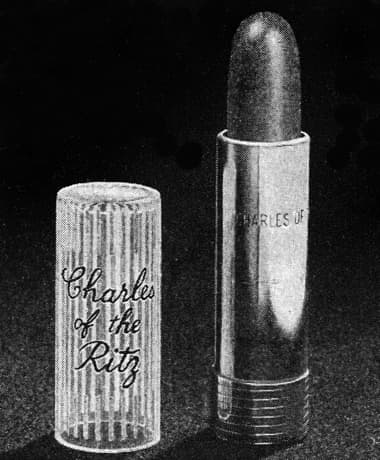
1958 Charles of the Ritz Treatment Lipstick.

1959 Charles of the Ritz pressed powder made to order in two new compacts.

1959 Charles of the Ritz Fresh Paint.
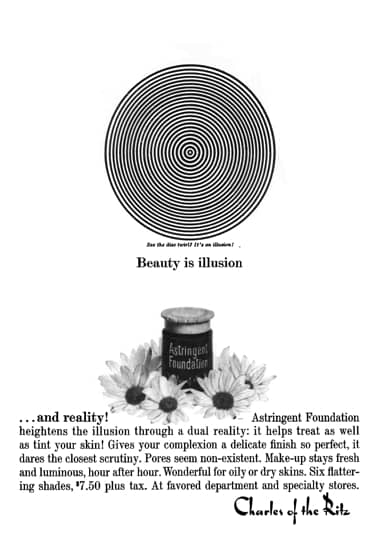
1960 Charles of the Ritz Astringent Foundation.
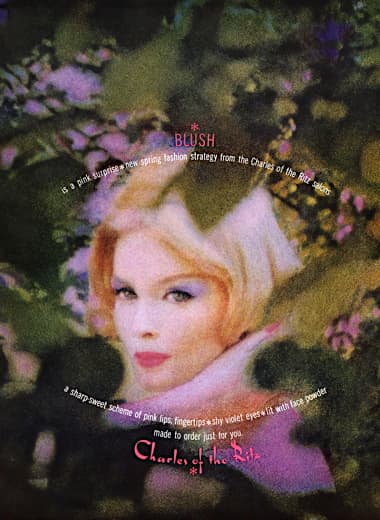
1960 Charles of the Ritz Blush.
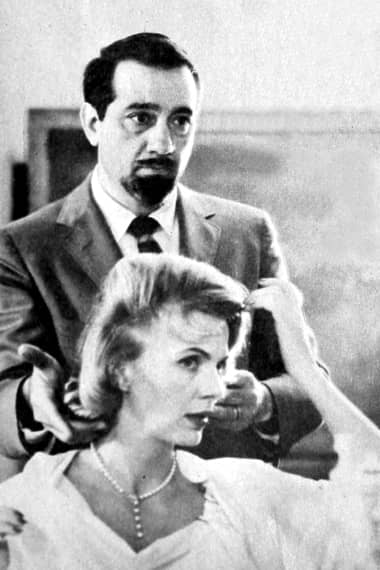
1961 Stylist Leon Amendola. Hairdressing continued to be an important part of Charles of the Ritz salons.
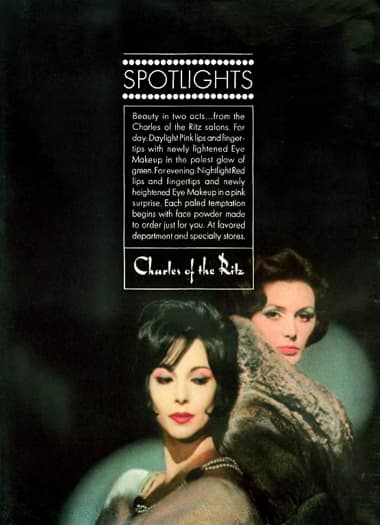
1961 Charles of the Ritz Daylight Pink and Nightime Red.
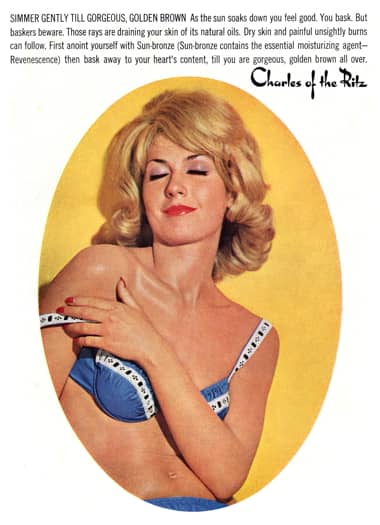
1962 Charles of the Ritz Sun-Bronze.
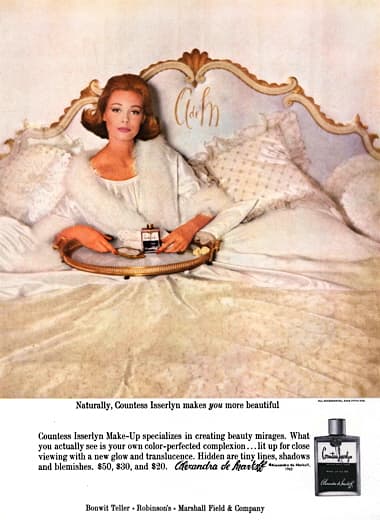
1965 Alexandra de Markoff Countess Isserlyn Make-Up originally from Anatole Robbins.

1966 Miss Ritz range.
